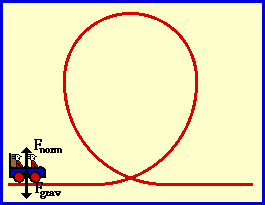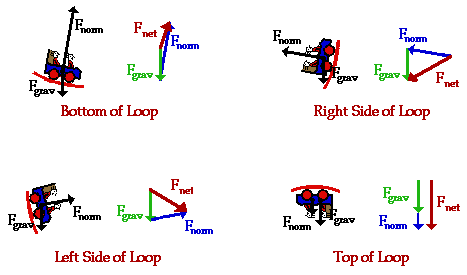Roller Coaster G-Forces
Roller coaster rides are notorious for creating accelerations and g-forces which are capable of transforming stomach contents into airborne projectiles. As a rider starts the descent down the first drop, she begins a one-minute adventure filled with various sensations of weightlessness, heaviness, and jerkiness. The parts of the ride which are most responsible for these sensations of weightlessness and heaviness are the clothoid loops. The explanation for the various sensations experienced on a roller coaster loop are associated with Newton's laws of motion and the physics of circular motion.
A clothoid loop has a constantly curving shape with sections which resemble the curve of a circle (in actuality, it is considered to be a section of a cornu spiral having a constantly changing radius). A coaster rider is continuously altering her direction of motion while moving through the loop. At all times, the direction of motion could be described as being tangent to the loop. This change in direction is caused by the presence of unbalanced forces and results in an acceleration. Not only is there an acceleration, the magnitude and direction of the acceleration is continuously changing. Within nearly a one second time interval, the riders may experience accelerations of 20 m/s/s downwards to 30 m/s/s upwards; such drastic changes in acceleration normally occur as the rider moves from the top of the loop to the bottom of the loop. These drastic changes in accelerations are the cause of much of the thrill (and the occasionally dizziness) experienced by coaster riders.
To understand the feelings of weightlessness and heaviness experienced while riding through a loop, it is important to think about the forces acting upon the riders. To simplify the discussion, we will assume that there are negligible amounts of air resistance acting upon the riders. Thus, the only forces exerted upon the riders are the force of gravity and the normal force (the force of the seat pushing up on the rider). The force of gravity is at all times directed downwards and the normal force is at all times directed perpendicular to the seat of the car. Since the orientation of the car on the track is continuously changing, the normal force is continuously changing its direction. The magnitude and direction of these two forces during the motion through the loop are depicted in the animation below.

For an object to move along a circular path at a constant speed, there must be a net inward force acting upon the rider. This is commonly referred to as the centripetal force requirement. The motion through a coaster loop isn't precisely an example of moving in a circle at constant speed since the loop is neither circular not the speed constant. Nonetheless, because of the similarity of the motion along the loop's path to uniform circular motion, principles of uniform circular motion can be applied to the rider. The net force acting upon the rider has an inwards direction (towards the center of the circle). Since the net force is the vector sum of all the forces, the head-to-tail addition of the normal force and the gravity force should sum to a resultant force which points inward. The diagram below depicts the free-body diagrams for a rider at four locations along the loop. The diagram also shows that the vector sum of the two forces (i.e., the net force) points mostly towards the center of the loop for each of the locations.

Feelings of weightlessness and heaviness are associated with the normal force; they have little to do with the force of gravity. A person who feels weightless has not lost weight. The force of gravity acting upon the person is the same magnitude as it always is. Observe that in the animation above the force of gravity is everywhere the same. The normal force however has a small magnitude at the top of the loop (where the rider often feels weightless) and a large magnitude at the bottom of the loop (where the rider often feels heavy). The normal force is large at the bottom of the loop because in order for the net force to be directed inward, the normal force must be greater than the outward gravity force. At the top of the loop, the gravity force is directed inward and thus, there is no need for a large normal force in order to sustain the circular motion. The fact that a rider experiences a large force exerted by the seat upon her body when at the bottom of the loop is the explanation of why she feels heavy. In actuality, she is not heavier; she is only experiencing the large magnitude of force which is normally exerted by seats upon heavy people while at rest.
For more information on physical descriptions of motion, visit The Physics Classroom Tutorial. Detailed information is available about the following topics:
Acceleration
Net Force and Acceleration
Free Body Diagrams
Weightlessness
Circular Motion and Tangential Velocity
Circular Motion and Acceleration
The Centripetal Force Requirement
Amusement Park Physics